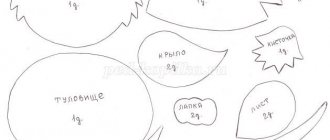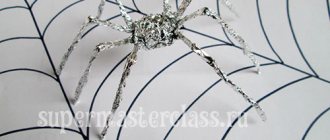Presentation “The Magic Land of Beads”
- May 2, 2011
Competition “Master of Presentations”
Purpose of the presentation: To introduce children to the history of beads.
Place of use: The presentation can be used in an introductory beadwork lesson for primary school students.
The effectiveness and practical significance of the presentation. With the help of a presentation, you can show and tell children that beadwork is one of the most fascinating types of decorative and applied art, combining simplicity of techniques, accessibility of material and the ability to quickly see the result of your work.
A little history
Just like any mill has its own history, beads have theirs. Its history is closely connected with the emergence of glass making. Yes, yes, glassmaking.
But let's start from the beginning. Until now, no one knows exactly when and where the glass was obtained. There is a legend according to which the Phoenicians (an ancient people, inhabitants of Phenicia) were the first to discover the secret of its manufacture.
The legend says that Phoenician merchants, returning from Africa on a ship loaded with soda, ended up in Syria. They landed on the shore and, deciding to cook their food on the fire, began to look for large stones to place the pot on. Having found nothing, the merchants used large pieces of saltpeter (natural soda) from the ship's cargo for this purpose. Due to the intense heat, the saltpeter melted, combined with the river sand and flowed like a stream of liquid glass.
Glass was invented one way or another, but it is reliably known that Phoenician traders sold products made from it in all Mediterranean countries.
According to another version, the birthplace of glass was Ancient Egypt. Glass beads, amulets, and dishes are found in tombs that date back to the 4th century BC.
By adding natural dyes to the glass mass, the Egyptians obtained glass of blue, green and purple colors. Beads made from such glass were very fashionable. They were worn by both men and women, often with white clothes. At home, Egyptian women did not wear clothes, but decorated themselves with necklaces made of colored beads.
Beads in Russia
Since ancient times, glassmaking was known in the territory of Ancient Rus', this is confirmed by archaeological finds. A large number of glass crafts and beads from the 9th-13th centuries were found during excavations in Kyiv, Novgorod and a number of other centers.
The small beads found, reminiscent of beads of various colors, could well have been locally produced, as evidenced by excavations of glass production workshops with remains of raw materials, semi-finished products, and various crafts, including beads.
Presentation “The Magic Land of Beads”
Author: Rykhta Svetlana Viktorovna, additional education teacher of the II qualification category, Municipal Educational Establishment Teenage Club “Ostrovok” in the city of Tarko-Sale, Yamal-Nenets Autonomous Okrug, Tyumen Region. Work experience – 2 years.
Presentation on technology on the topic “Beading”
#8th grade #9th grade #10th grade #11th grade #Technology #Educational materials #Presentation #Subject teacher #School education
Beading Prepared by Svetlana Valentinovna Serykh, technology teacher of the MKOU "Ozerninskaya Secondary School"
The history of making products from beads, small beads and bugles goes back several thousand years, remaining to this day one of the favorite types of decorative and applied art. Beads and glass beads are used to decorate clothes, hats, shoes, all kinds of accessories, make jewelry, collars, covers for various items, decorative items, embroider paintings and panels.
Products made from small beads and beads were known in the countries of the Ancient World. Until now, among many peoples of Africa, North and South America, Europe, Asia, and Australia, this type of folk art is an integral part of culture.
The Legend of the Appearance of Glassmaking Beads got their name from the Arabs - “buera” or “buser”, which translated means “fake pearls”. Its appearance is directly related to glassmaking. The legend about the emergence of glassmaking says that once merchants from Phenicia transported natural soda from the African Nile Valley across the Mediterranean Sea and landed on the sandy shore for the night. The merchants lit a fire to cook food on it, but it turned out that there was nothing to cover it with. Then they came up with the idea of using pieces of soda for this purpose. In the morning, in the ashes, to their great surprise and joy, the merchants discovered a solid sparkling ingot, beautiful and pure as water. This is how glass appeared.
The discovery of the technique of blowing glass using a pipe is, according to one version, attributed to the Phoenicians, according to another - to the Egyptians. One way or another, this made it possible, along with the production of valuable glass using very complex technology, to produce large quantities of light, thin-walled, hollow glass. Almost immediately, one of the trends in glassmaking of this time was the production of small beads and bugles. They were made in different ways, the essence of which boiled down to the following: thin multi-colored glass tubes were cut into small pieces with guillotine-type scissors. By adding copper, manganese, cobalt and other materials to the glass melt, ancient craftsmen obtained glass of green, purple and blue colors. Beads made from such glass were very popular among both women and men. In the frescoes that were used to paint the walls of widows' tombs and tombs, you can see how varied their use was.
In addition to glass, in the 19th century. metal beads appear: copper, gold-plated, steel. In Paris, beads began to be made from gold, silver, steel and other metals. Later, cheaper versions of SUCH beads appeared: massive metal glass beads were coated with amalgam or molten tin to obtain silver beads, and golden beads were obtained using a weak solution of ferrous sulfate and gold chloride.
Old Russian craftsmen used semi-transparent glass of different colors to make beads: green, blue, yellow, violet, black, silver and gilded. Glass beads were very diverse in size, shape, color and artistic treatment. They were used in costumes and decorations of all segments of the population, not only for girls and women, but also for children and men.
After the revolution of 1917, almost all educational institutions were closed, but the love for beaded jewelry and the ability to create them remained. Particularly striking surges of interest in beading and bead embroidery were noted in the pre- and post-war years, as well as the 1970s.
Presentation: Country of beadwork Completed by: students of the beadwork association. - presentation
Presentation: Country of beadwork Completed by: students of the beadwork association.
How did beading develop? To answer this question we took a trip into the past.
Just as any country has its own history, so do beads. The art of beading has been known to man since ancient times. The history of beading and bead production is as interesting as jewelry made from the beads themselves.
We have returned to distant times. And they saw that initially the beads did not look quite familiar to modern people: small shells, teeth, grains, small bones acted as beads and beads, which in the hands of the master turned into original jewelry.
Traveling further, we learned that in North Africa (about 6,000 years ago), Phoenician merchants invented wonderful transparent ingots that were hard as stone, burned in the sun and were clean and transparent like water. This was the first glass.
The ancient Egyptians learned to make glass 4,000 years ago and began using it as jewelry. They decorated clothes, necks, arms and legs with multi-colored shiny balls. Glass beads, the immediate predecessors of beads, adorned the clothes of ancient Egyptian pharaohs. At first, the beads were strung on horsehair, then on blades of grass, and later on threads. This is how beadwork was gradually born. The ancient Egyptians learned to make glass 4,000 years ago and began using it as jewelry. They decorated clothes, necks, arms and legs with multi-colored shiny balls. Glass beads, the immediate predecessors of beads, adorned the clothes of ancient Egyptian pharaohs. At first, the beads were strung on horsehair, then on blades of grass, and later on threads. This is how beadwork was gradually born.
We further learned that for several centuries the only center of bead production in Europe was the Venetian Republic. The beautiful and durable material was used in interior design, for finishing folk costumes and religious objects; it could be seen in palace halls, in landowners' estates, and village huts. We further learned that for several centuries the only center of bead production in Europe was the Venetian Republic. The beautiful and durable material was used in interior design, for finishing folk costumes and religious objects; it could be seen in palace halls, in landowners' estates, and village huts.
Over time, Egyptian glassmakers began to compete with Venetian glass, and Phoenician, Danish, and Dutch beads appeared. Types and forms of beads developed, new production secrets emerged, and bead products gained popularity. The production of beads moved to an industrial basis.
In the 18th century, bead art became very popular in Russia. Beads are used to embroider clothes, hats, shoes, and make jewelry.
Now beads have found wide use among fashion designers in finishing women's clothing, and interest in beads has again swept the whole world. Beading has become one of the types of creativity.
Conclusion: A person always strives to be beautiful. Following folk traditions, many craftsmen in our country create a variety of jewelry of new shapes, patterns, and colors. They are an excellent addition to modern clothing: openwork, lace-like, mesh narrow and wide collars; all kinds of neck chains, twisted cords and many others. You can make a belt for a dress, straps for a sundress, a bracelet and earrings, headbands and much more. These are worthy gifts and doubly pleasant because they are made with your own hands.
Used literature: Artamonova E. Jewelry and souvenirs made of beads. - M., 1993. Artamonova E. Jewelry and souvenirs made of beads. - M., 1993. Bondareva N.A. Beadwork.-Rostov-on-Don, 2000 Bondareva N.A. Beadwork.-Rostov-on-Don, 2000 Beadwork. Ed.-comp. O.G. Zhukova. - M.: Knowledge, 1998. Beadwork. Ed.-comp. O.G. Zhukova.- M.: Knowledge, 1998. Romanova L. A. The magic of beads. Romanova L. A. The magic of beads Internet resources. Internet resources.
Presentation of the project "Beadwork" 3rd grade.
Municipal budgetary educational institution "Secondary school No. 4" Saratov region Engels Creative project on the topic: "Beading"
Classroom teacher
: primary school teacher Tatyana Vladimirovna Makarova
2018
Project participants
: students, parents, class teacher.
Project methods:
- problematic;
-partially search; — Project type:
creative
Project duration:
long-term
Target:
creating a collection of products made using the beading technique.
Objectives:
- find out the history of the appearance of beads; — get acquainted with different types of beading; - tell your classmates about beadwork; — to interest peers in beading technology by holding an exhibition and presentation of their works.
Stage I. Relevance.
It's always nice to add beauty to the world with your own hands. Time erases entire states, many species of animals, birds and fish from the face of the Earth. Consigns to oblivion the customs of many peoples. But neither a powerful earthquake, nor hurricanes, nor floods, nor wars could destroy such a seemingly unnecessary human need as the desire for beauty. Beauty is the greatest work of man. Since ancient times, man has sought to decorate himself and his life. This is evidenced by the wondrous beauty of carved frames and wooden utensils, toys and painted dishes, embroidery and lace, clay vases and wall decorations, necklaces, earrings and bracelets. Beading is my favorite activity. I've been doing it for over a year. I love making things with my own hands from these small, colorful, magical beads. These are extraordinary, fabulous things. And these products can also be given as gifts, because although they are small, they are made with love. These are not just decorations, but products that absorb not only the warmth of hands, but also feelings, mood and wishes. I wanted to know about the origin and use of beads, about the types of beadwork.
II.
Main part. 1. History of beading .
When did beads appear? Historians have not been able to establish the exact time of its appearance. The name “beads” itself comes from the Arabic word “buser”, “busra” - fake pearls, and the history is connected with the emergence of glass. Glass was known to man more than 5 thousand years ago. Most likely, the ancient potters were the first to become acquainted with glass: during firing, a mixture of soda and sand could get onto a clay product, and a thin translucent film would appear on the surface. This was the first glass. Around 1200 BC, colored glass appeared. Iron, cobalt and copper were added to the glass mass, and the resulting glass was blue, turquoise, green or light blue. The Egyptians often used this type of glass to replace natural stones - turquoise and malachite - in jewelry. And multi-colored shiny balls - the first beads - were used to decorate clothes, necks, arms and legs. At first, beads were strung on blades of grass, horsehair, and later on threads. This is how beadwork was gradually born.
In those ancient times, glass seemed to people a divine miracle, because it was born of earth and fire and was so unlike everything that surrounded man. Beads were exchanged for silk and spices, gold and silver, and in Africa they were even used as bargaining chips. In European countries, very small and shiny beads were highly valued. The needlewomen used silver-plated, gilded and brocade beads - polished from the inside. In each country, the production of beads and their use have their own characteristics, inextricably linked with national traditions and art. For example, in Russia, women's monasteries were centers of beadwork. It was there that the technique of embroidering icons with both threads and beads originated. They embroidered headdresses, hems and collars of shirts, straps of sundresses with beads, wove neck ornaments, trimmed shoes, smoking pipes, and collars for pets. Currently, the main bead producers in the world are the Czech Republic, Taiwan and Japan. Famous fashion designers actively use beads when decorating modern clothes. Today's fashionistas are happy to wear outfits with such decoration. Recently, interest in beads has once again swept the whole world. And beadwork has become one of the types of modern creativity.
2. Types of beads
Beads are a very ancient material.
It is the main material for making various toys, jewelry, weaving and embroidery. Modern beads are very diverse and are made from different materials. It can be glass, ceramic, plastic or metal. Beads are painted in a variety of colors and shades; beads are made two-color, three-color, and even with a pattern. The size and shape are also very diverse. There are several main types of beads: - round, which is the most common; - drop-shaped, the holes of which are shifted to the edge; - Bohemian - small beads, cut like a large round crystal. Another material is glass beads (tubes from 3 to 7 mm long), and also chopped glass beads, i.e. short tubes (Appendix 1).
3. Weaving technique
The parallel weaving technique
is the making of beads on wire.
This technique is used to weave petals and leaves, which can have a flat, concave or convex shape. The needle weaving technique
is when, while weaving, we string two beads onto each wire, move the last bead a little to the side, pass the end of the wire through the first and tighten the loop.
Circular weaving
– this technique is very well suited for making large petals and leaves. It is more complex than parallel weaving and can require considerable effort to master.
4. Types of bead work
.
Lowering
is weaving of beads into several threads with beads strung on them.
This technique is used to make various decorations: beaded collars, necklaces, baubles, beads, hairpins, brooches, toys. Weaving
is performed on a special machine.
The technique for making such products is not complicated, but it requires patience and attention. This is an ancient manufacturing technique. For weaving, patterns and designs of cross stitch or texts and ornaments drawn on checkered paper are used. Bead embroidery
- this technique has been known for a long time.
As soon as beads appeared, needlewomen began to use this material in ancient art. (Appendix 2)
In my work I use the technique of lowering. On weekends, my mother and I weave jewelry. We find types of work on the Internet and books. (Appendix 3).
5. My research
To find out whether the beading technique is a modern form of creativity, I conducted a survey among children and adults.
Is beadwork a hobby for children or adults?
A survey among children and adults showed that beadwork is a hobby for both children and adults. Children and adults do different types of beadwork as a hobby, to give gifts, just as a hobby. The survey showed that many adults and children know how to weave, knit, and bead embroidery. Everyone likes products made using the beading technique, and those who do not yet know how to weave would like to learn how to embroider. After conducting research, we came to the conclusion that beadwork is a modern form of creativity that is enjoyed not only by adults, but also by children. Working with beads develops perseverance and fine motor skills.
III. Conclusion
After studying this topic, I learned a lot of new and interesting things about beads.
All beads can be divided into 5 large groups: chopped beads, glass beads, beads, rhinestones, sparkles. Depending on the type of work, special equipment is used. Before you start weaving, you need to:
- organize your workspace - free up enough space so that there is room to lay out the material and tools, choose a comfortable seat, and there must be good lighting. — provide yourself with good lighting and from time to time take a break from work to rest your eyes, because beading is long and painstaking work and your eyes are constantly under strain. - You should first master the basics and various easy techniques, gradually complicating them.
I have a lot of interesting beadwork ahead, and I will continue to improve my skills. I will continue to master more complex types of weaving. I plan to learn how to weave jewelry, make toys and souvenirs using other beading techniques. I will continue to study special literature related to beadwork, find interesting works and try to implement them in my works. Beading is a wonderful, creative hobby! Thank you for your attention!
IV. Bibliography
1. Andriyanova O. “Beads and glass beads. Fantasies and ideas" M. "ROSMAN" 2. Lyudmila Bozhko "Beads" M. "Martin", 2002. 3. Internet resources (pictures)
Appendix No. 1
round teardrop-shaped
glass beads Bohemian
Appendix No. 2
Appendix No. 3
History of beading lesson presentation
Slide 1
History of beading
Slide 2
The history of beads goes back to the distant past... The material, magnificent in its decorative qualities, has attracted the attention of craftsmen since time immemorial. The art of creating jewelry appeared almost at the same time as people appeared. Beads have been relevant since the time of the first civilizations and were used by our ancestors as decorations, as well as to protect themselves from evil spirits. Initially, the beads did not look quite familiar to modern people. The role of beads and beads were small shells, teeth, grains, small bones, which in the hands of the master turned into original jewelry. jewelry of primitive people
Slide 3
In North Africa (about 6,000 years ago), Phoenician merchants invented wonderful transparent ingots - glass. The legend about the emergence of glassmaking says: “Once upon a time, in very distant times, Phoenician merchants transported a cargo of natural soda mined in Africa across the Mediterranean Sea. For the night they landed on a sandy beach and began to prepare food for themselves. Due to the lack of stones at hand, they surrounded the fire with large pieces of soda. In the morning, while raking out the ashes, the merchants discovered a wonderful ingot, which was hard as stone, burned in the sun and was clean and transparent like water. It was glass."
Slide 4
Making jewelry from beads has a very ancient history. The ancient Egyptians learned to make glass 4,000 years ago and began using it as jewelry. The first beads for decorating clothes Glass beads IX-XII centuries. The first glass products
Slide 5
They were very sensitive to beads, as evidenced by the fact that they wove them into the famous necklace of the Sun, which was a symbol of the unlimited power of the pharaoh. Glass beads - the immediate predecessors of beads - decorated the clothes of the ancient Egyptian pharaohs. At first, the beads were strung on horsehair, then on a blade of grass, and later on threads. This is how beadwork was gradually born. All kinds of jewelry were also woven from beads: necklaces, large beads, bracelets, brooches, etc.
Slide 6
Following Egypt, beads appeared in Syria. The secrets of these peoples were adopted by the Roman Empire. Gradually, beadwork - patterns and original products - began to cover the whole world. The Romans traded beads throughout their empire. The ancient Celts and Vikings also knew beadwork, had patterns and patterns, made beads and bracelets, and also decorated clothes. Beads were known in the Ancient world. For some peoples it served as a bargaining chip. From the 5th to the 12th centuries, the Byzantine Empire was the center of the world, especially when it came to culture and fashion. Thanks to extensive trade, it flourished. Constantinople was one of the most important cities of the time, where everything exuded wealth and luxury. Luxury goods from the most exotic places were exchanged in its markets. Theodora wearing earrings, necklace and crown with pearls and precious stones. jewelry from the D&G collection
Slide 7
Around the 6th century, the art of beading reached its peak in Byzantium, from where it moved to Venice, which became the leader for a long time. Byzantine craftsmen who discovered the secrets of making colored and transparent glass gained worldwide fame. The color, combination of colors and shape of the beads had a symbolic meaning; they could tell not only about a person’s social origin, but also about his worldview and the events that took place. Color combinations symbolized youth and old age, happiness and sorrow, birth and death.…
Slide 8
On the territory of our country, products made of glass, beads and beads were already known in the 6th – 5th centuries BC. The Scythians and Sarmatians, and at the beginning of our era - the ancient Slavs, decorated their clothes with them. Scythian decoration Since the 17th century. Attempts were made to organize bead production in Russia with the help of foreign craftsmen. In the village of Izmailovo near Moscow in 1668-1669. Construction of a glass factory began. After construction was completed in 1670, Venetian craftsmen arrived in Moscow. But it was not possible to establish constant production. Only Lomonosov managed to organize bead production in Russia. The great scientist asked for permission to build a factory, citing data on hundreds of pounds of beads and glass beads brought into the country through the St. Petersburg port. decoration of the ancient Slavs
Slide 9
In the 18th century, bead art became very popular in Russia. Beads are used to embroider clothes, hats, shoes, and make jewelry.
Slide 10
At the end of the 18th-19th centuries, the passion for beaded crafts in aristocratic circles was so significant that it became an integral part of the culture and life of Russia. The tradition of sewing and beading brought a lot of good into human life. The girls became patient, hardworking, sincere and accustomed to beauty, had exquisite taste, and were friends with inspiration! And of course, when the question arose about what material to work with: bright and sparkling beads or simple threads, many girls chose beads. Thanks to this, the unfading colors of glass beads have brought artistic images of the past to our time, preserving the original color intent of their creators.
Slide 11
Almost all household items were decorated: wallets, boxes, hats, beads and pearls in Rus'
Slide 12
Clothing, writing utensils. brushes
Slide 13
nuns in monasteries embroidered icons and clergy clothes.
Slide 14
Glass bead tapestries decorated walls in palaces, including imperial ones. An example of this is the glass bead cabinet of the Chinese Palace in Oranienbaum near St. Petersburg. Its walls are decorated with glass beads produced at the Lomonosov factory.
Slide 15
At the beginning of the 19th century, the “bead fever” spread from fashionable capitals to provincial towns and rural estates. At the end of the 19th century, when inexpensive beads appeared, this needlework took root in peasant houses. Neck beaded jewelry - necklaces, markings (right), 19th century.
Slide 16
With the beginning of the scientific and technological revolution, with the advent of new materials and fabrics, interest in beads waned. But everything new is forgotten old, and in our time interest in bead products has again begun to gain momentum, many existing technologies have been improved and new ones have appeared - the manufacture of wire-based products
Slide 17
At the end of the twentieth century, the time for the revival of beadwork came again. Talented masters carefully preserved their art. And now this type of needlework again pleases us with its uniqueness and grace. Now beadwork is in demand again. Beads will add charm and brightness to your clothes. Products made from beads shine on catwalks, in boutiques; beads decorate jewelry and clothing, wallets, handbags, collars, belts and other accessories. Many designers use the beauty of beads in all the variety of their shine and color.
Slide 18
Modern jewelry made of beads and bugles, like ancient ones, fit perfectly with clothing, complementing and decorating it.
Presentation on the topic “History of the appearance of beads”
The history of beads
The word “beads” itself is of Arabic origin, it is derived from the word “busra”.
The very first bead products were made in the country of sphinxes and pyramids - Egypt
The history of beads goes back to the distant past. The material, magnificent in its decorative qualities, has attracted the attention of craftsmen since time immemorial.
Glass beads - the immediate predecessors of beads - decorated the clothes of the ancient Egyptian pharaohs. In those distant times, beads were little similar to modern ones; they were round frosted beads made of opaque glass. At first glance, these beads looked very similar to pearls, which is why they were called fake pearls. Over time, the size of the beads changed, they became smaller.
The ancient Egyptians were very sensitive to beads, as evidenced by the fact that they wove them into the famous necklace of the Sun, which was a symbol of the unlimited power of the pharaoh. All kinds of jewelry were also woven from beads: necklaces, large beads, bracelets, brooches, etc., stringing beads onto horsehair.
From Egypt, beads came to Rome. The Romans learned from the Egyptians the art of glass making and mastered the basic techniques of bead weaving.
Around the 6th century, the art of beading reached its peak in Byzantium. From there it moved to Venice, which became the leader for a long time. Byzantine craftsmen who discovered the secrets of making colored and transparent glass gained worldwide fame.
The color, combination of colors and shape of the beads had a symbolic meaning; they could tell not only about a person’s social origin, but also about his worldview and the events that took place. Color combinations symbolized youth and old age, happiness and sorrow, birth and death.…
Beads in Rus'
Glass beads were a favorite decoration of Russian beauties from Moscow to Kyiv.
The hobby for beads became popular among all classes: from peasants to noble houses. Almost all household items were decorated: wallets, boxes, hats, tobacco pouches, card sets, tablecloths, candlesticks, albums, writing instruments, and dishes.
Glass beads
There are hundreds of bead models in the world. However, they are mainly created using four methods:
• twisted glass;
• drawn glass;
• cast glass;
• blown glass.
Twisted glass:
- The beads are made one by one, winding liquid glass around a rod, the axis of which is lubricated with clay or salt so that the glass does not stick. The beads are removed from the rod as soon as they have cooled.
Drawn glass:
- The molten glass is collected into a long, hollow metal rod through the end, then placed in a furnace. The mass spreads throughout the rod. It is then pulled out from the other end. As soon as the resulting thin glass rod has cooled a little, it is cut into long pieces, then into small cylinders the size of the beads.
Modern beadwork is not just the production of women's jewelry and accessories, but one of the types of fine art.








